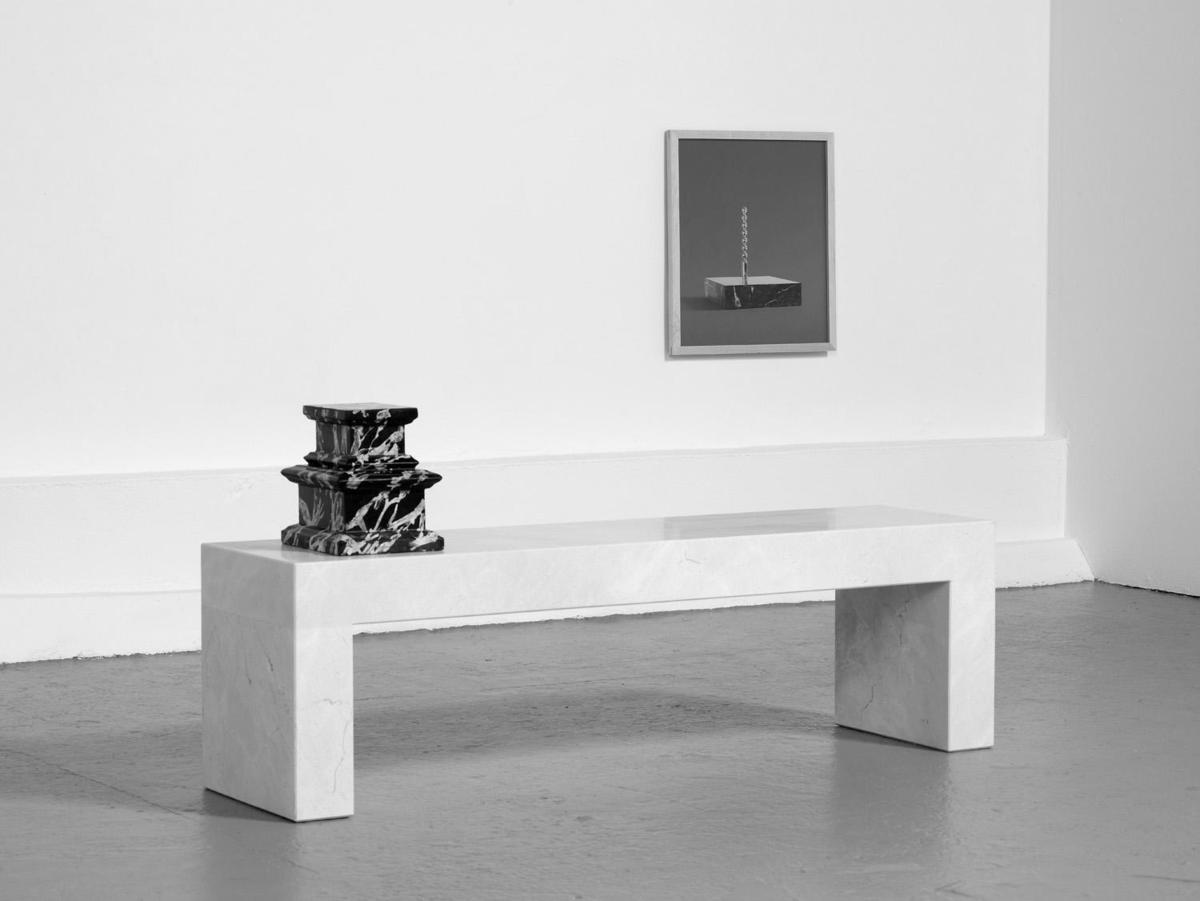
London
Shahryar Nashat: Workbench
Studio Voltaire
March 31–May 14, 2011
For something that greets the eye as a study in quietude and restraint — a few modified plinths and benches, a clutch of remote brass sculptures (and photographs of same), a video that feels preparatory to an unseen event — Shahryar Nashat’s first London solo show, Workbench, discloses itself as a quivering, quietly anxiety-producing affair. Pretty much everything here turns out to be assuredly askew in some way, and there’s a consistent, orchestrated sense that looking at its elements means broaching some kind of category error, or glimpsing the semaphoring of something absent. The Swiss artist’s exhibition, in short, languidly undoes itself while you wait. Travertine Bench with Accompanist (2011), for example, is a long, low seat in creamy travertine topped, at one end by a tiered, funerary-looking, black-and-white marbled plinth. The smaller work almost completes the larger, which offers it a resting place. But at the same time, this is a support supporting a support. The plinth appears to await something else — a sculpture, a vase of flowers — and also leaves enough space on the bench for the viewer to sit down beside it. Do you accept? Are you the endpoint? The unresolved question of how to — or how not to — interact with these propositions speaks to their finessed ambivalence.
Not the Stuff of Stone (2011), across the room, mirrors Travertine Bench… while covertly switching mediums: it’s made of plaster painted with a low-grade marbling effect. Let’s talk hierarchies: is this — a painterly faking that swiftly admits as much — more specifically “sculptural” than its non-identical twin? Does it make the latter more functional, downgrading it? Two Thighs Rooted in Marble (2010) modulates the indecision: twin abstract columns of brass balls, rising from a marble block, ask to be read as limbic — and taken seriously as sculpture when they look pretty decorative, vaguely ecclesiastic. They sit near the show’s largest piece, Gleaming Brass Straddling a Glass Cabinet (2009), two sheets of glass at a ninety-degree angle, connected by brass strips in a very deliberate fashion — fairly practical yet lightly aesthetic — and perched on a constructed wooden box. Again, this maybe waits to display something but verges on being enough, minimally so, on its own. Nashat knows how to accentuate the thin but tangible space between background and foreground; here, he’s showing off a bit.
Gleaming Brass sits between Two Thighs and a plinth/bench piece, Travertine Bench with Absent Accompanist (2011), in a constellated way that, with elegant vacillation, half-posits a relationship between the three, though the mooted intersection is unclear: the spacing between them seems gauged so that the works neither pull together nor stand apart. The handout list of works, meanwhile, lists the works not in a standard clockwise order but on a diagonal trajectory through the gallery, as if inferring a correct path through the show. That’s surely not accidental, and if it is now increasingly apparent that these registers of tension — this where’s-the-work, what-am-I-missing vibe — mark out Nashat’s basecamp, The Rehearsal of Adam Linder (2011) confirms it. The three-minute video of a dancer rehearsing is consciously ancillary to something we’ll never see: the dance itself. His spasm-like dance moves, too, fall between stools, looking like they could be warm-up exercises or an epileptic fit. Every few seconds, a blue screen featuring the work’s title and details flashes up, throwing us off further when we’re already unbalanced.
The strange thing is that these accumulating stresses become something to take pleasure in. Nashat is operating in a very au courant corner of art practice that borders on an instrumentalizing of bad faith. Well aware of how hierarchies are stacked in contemporary art (what should be at the center, what at the edge; when interaction is appropriate, when not), his art refuses in various ways to give itself up, and you’re invited to ask how deliberate that is. His refusals and feints — deciding, for instance, to photograph his brass sculptures against specific colored backgrounds, on a specific scale, and hang them specifically low, as in Photoscaled 1 (Cyan) (2011) — are reassuringly programmatic. The supposedly sophisticated art viewer, as a result, is permitted the pleasurable spectacle of watching someone who understands the contemporary parameters of viewing cleanly upend them. “Well played,” one may murmur, moving diagonally through the show, processing from individual doubts to compound ones. And compounding the doubt leads, ironically, to a feeling of security, since the precise tenor of not knowing becomes familiar.
This can pall, too. Here, I found myself looking quizzically but with tense gratification at a thin fold of foam rubber holding the “accompanist” sculpture separate from the bench in Not the Stuff of Stone. It seemed like it might be serving a practical purpose: to stop the smaller element from scratching the painted workbench’s top, perhaps. Then again, it might have been entirely functionless and just there deliberately to screw with one’s synapses. Or it might have been an actual mistake, something that ought to have stayed hidden. My eyes recalibrated by Nashat’s nuancing of looking, I nevertheless couldn’t make my mind up and felt properly mapless. Within this controlled economy of interpretation, the tiny wayward scrap of material felt like the exhibition’s errant, beating heart.